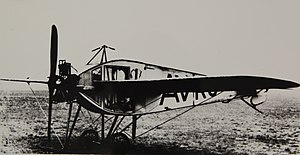| Type F | |
|---|---|

| |
| Role | Experimental aircraft |
| Manufacturer | A.V.Roe and Company |
| First flight | 1 May 1912 |
| Number built | 1 |
The Avro Type F was an early single seat British aircraft from Avro. On 1 May 1912 it became the first aircraft in the world to fly with a completely enclosed cabin for the pilot as an integral part of the design.[1]
Design and development
[edit]It was a wire-braced mid-wing monoplane with a tailskid undercarriage. The fuselage was teardrop-shaped with flat sides and cellon windows. Oil leakage from the engine had been anticipated to obscure pilot view by coating cabin windows; so two circular windows at the pilot's head level could be opened for the pilot's head to protrude when flying, but their use proved unnecessary. Ingress and egress was via a sheet-aluminum trapdoor in the fuselage top.[1] The cabin was quite cramped, being only 2 ft (60 cm) across at its widest point.
The Type F made a few test flights in mid-1912 until damaged beyond repair in a hard landing on 13 September, after which it was not repaired. Its Viale 35 hp engine is on display at the Science Museum in London; and the rudder was preserved by the Royal Aero Club.[1]

A replica, BAPC.328. is displayed at the Avro Heritage Museum in Woodford, Greater Manchester.
Specifications
[edit]Data from [1]
General characteristics
- Crew: one pilot
- Length: 23 ft 0 in (7.01 m)
- Wingspan: 28 ft 0 in (8.53 m)
- Height: 7 ft 6 in (2.29 m)
- Wing area: 158 sq ft (14.7 m2)
- Empty weight: 550 lb (250 kg)
- Gross weight: 800 lb (360 kg)
- Powerplant: 1 × Viale 35 hp 5-cylinder radial , 35 hp (26 kW)
Performance
- Maximum speed: 65 mph (105 km/h, 56 kn)
- Rate of climb: 300 ft/min (1.5 m/s)
References
[edit]- Taylor, Michael J. H. (1989). Jane's Encyclopedia of Aviation. London: Studio Editions. p. 91.
- World Aircraft Information Files. London: Bright Star Publishing. pp. File 889 Sheet 92–93.
- Avro Type F – British Aircraft Directory
Well, that’s interesting to know that Psilotum nudum are known as whisk ferns. Psilotum nudum is the commoner species of the two. While the P. flaccidum is a rare species and is found in the tropical islands. Both the species are usually epiphytic in habit and grow upon tree ferns. These species may also be terrestrial and grow in humus or in the crevices of the rocks.
View the detailed Guide of Psilotum nudum: Detailed Study Of Psilotum Nudum (Whisk Fern), Classification, Anatomy, Reproduction